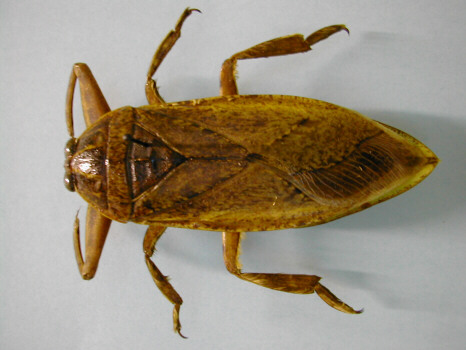|
|
||||
|
The Giant Water Bug a predator bug who hunts mosquitoes and other pest insects in the water. They are big bugs and are very well-suited for hunting in the water Their forelegs have a hook-shaped claw that they use to grasp and hold prey. Water bugs grab hold of a plant that is growing close to the surface of a fresh water pond or stream and hide until they can snatch a bug or small fish that is passing by. Instantly, the Giant Water Bug pierces its victim with its sharp beak and injects a powerful poison. The poison has two purposes. First, it paralyzes the prey. Then, it liquefies the internal parts of the prey's body so Giant Water Buy can suck up a liquid dinner. Giant Water Bugs eat lots of different kinds of water insects, crustaceans, tadpoles, salamanders, fish, and amphibians. The Giant Water Bug can catch and eat an animal 50 times its size. This would be the same as a person eating up a whole elephant milkshake in one sitting! The Giant Water Bug is one of the largest insects in the U.S. and Canada. Giant water bugs are approximately 1.5 inches (3.8 cm) in length. Some species grow as long as 4 inches (10 cm). Because these bugs are often found under street lights and around porch lights, they are also one of the insects people ask most about. The Giant Water Bug is commonly mistaken for a beetle or even a cockroach. Some people call them " toe biters" because they can deliver a nasty bite. Other people call them "electric light bugs" because they are attracted to lights.
Giant Water Bugs like to live near clear, freshwater streams and ponds, preferring those with lots of vegetation. Giant Water Bugs like to swim slowly through water, especially where they can find vegetation such as cattails. They usually grab hold of a plant near the surface, and stick their short breathing tube out of the water to allow them to breath while waiting for their prey to come along. With their powerful front legs they are able to grab other bugs and prey (such as small fish, frogs and salamanders). Giant water bugs are called ambush hunters because they stay perfectly still and waiting for their prey. When sitting motionless, giant water bugs resemble dead leaves. This allows them to hide from both potential prey and possible predators. Predators of giant water bugs include birds, fish and other aquatic predators. Adult giant water bugs capture larger prey species by using their clawed front feet and chemicals which are injected into the body of the prey. The enzymes turn the prey’s insides into liquid, which the giant water bug can suck up. Most Giant Water Bugs live for about one year - but some live longer.
The Giant Water Bug has piercing,
sucking mouth parts, and a short, pointed beak on the underside of the head.
The other distinguishing characteristic is the fact that the wings overlap at
the hind end of the abdomen, forming an X like pattern. Other than that, the
big size of the insect and the unusual shape of the front legs help identify it. Although not really dangerous, the Giant Water Bug can give a nasty bite. One person described the bite as very painful, causing the finger and whole hand to swell up for about two weeks. If you are going to handle this insect, it should be done with care.
|


